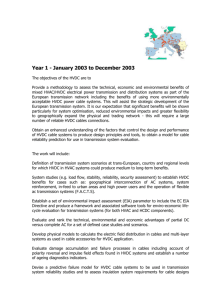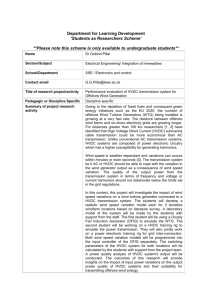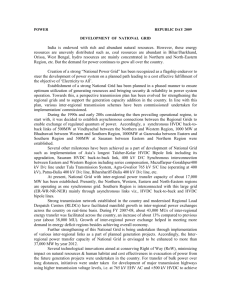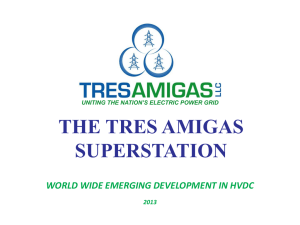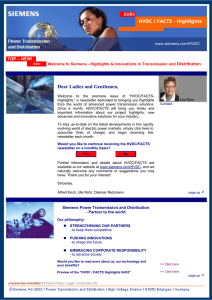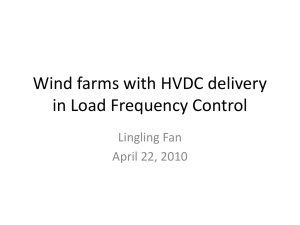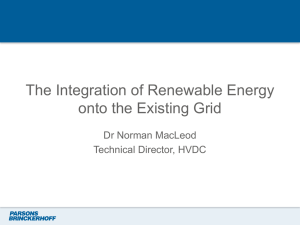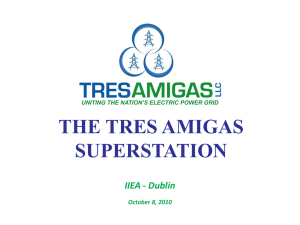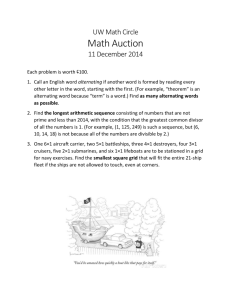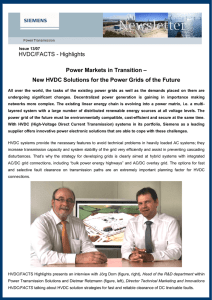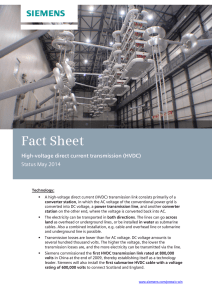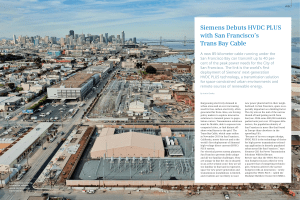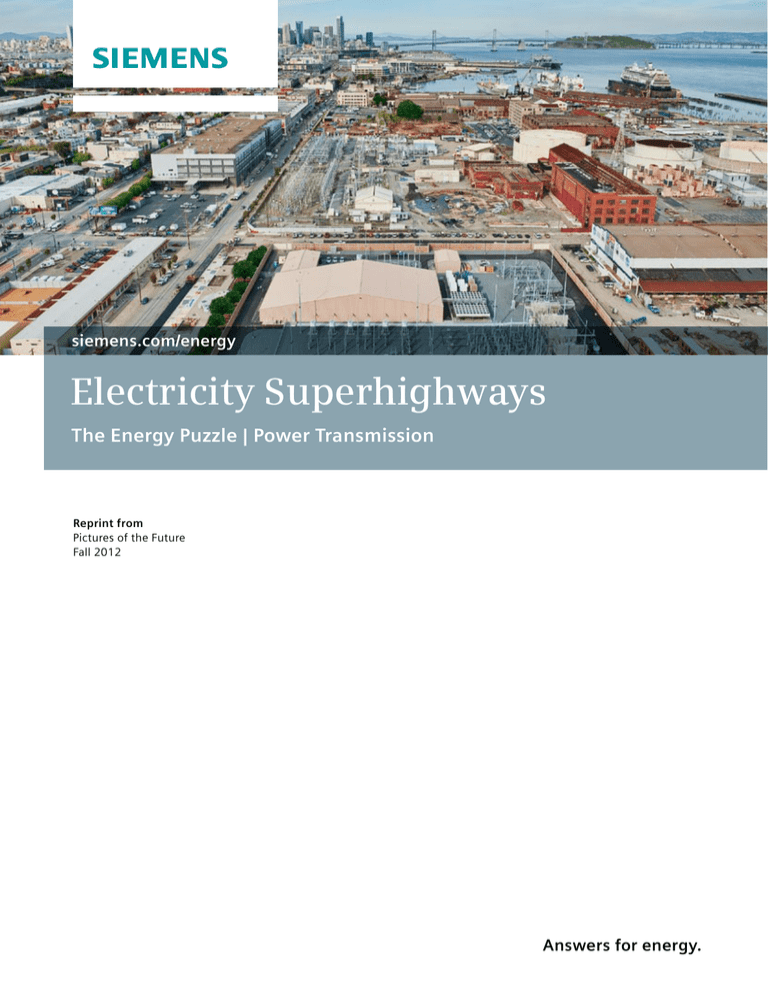
siemens.com/energy
Electricity Superhighways
The Energy Puzzle | Power Transmission
Reprint from
Pictures of the Future
Fall 2012
Answers for energy.
The high voltage direct current (HVDC) connection
that links Majorca with the Spanish mainland
supplies clean electricity to the island. The HVDC
station pictured here converts the transmitted
direct current back into alternating current.
The Energy Puzzle | Power Transmission
Electricity Superhighways
The creation of a sustainable energy system requires the expansion of long-distance power transmission networks. The problem is that transporting high voltages over long distances with conventional
alternating current causes prohibitively high losses. What’s more, new lines often meet with considerable public resistance. Pictures of the Future examines some surprisingly efficient alternatives.
R
enewable energy sources should be used
wherever they are abundantly available
— from wind power on the high seas to solar
energy in sunny regions. Germany, for instance,
plans to build wind farms with up to 30 gigawatts of capacity in the northern part of the
country between now and 2020. But most of
its energy consumption is in the south. So the
real question for Germany is how to get its
renewably-generated electricity from the north
to the south. Existing power lines can’t do the
job; already, clean electricity from the north
often has to be redirected through Germany’s
eastern and western neighbors in order to get
to the south. A huge expansion of the grid
therefore appears to be unavoidable. In response to this challenge, Germany’s federal
government and the country’s four power
Pictures of the Future | Fall 2012
transmission companies presented a grid
development plan in May 2012. The plan calls
for the construction of 3,800 kilometers of
new transmission lines over the next ten years.
After it’s completed, this colossal project could
serve as a model for sustainable energy supply
systems in other countries, especially if, as is
the case in Germany, a large share of renewable energy sources is situated far from major
energy consumption centers.
Can the German grid be expanded as quickly
as planners would like? “Losses over just a few
hundred kilometers would be too high with
the alternating current technology that’s generally been used to date,” says Professor Dirk
Westermann, Director of the Electrical Energy
Supply Department at Ilmenau University of
Technology (east of Frankfurt, Germany) and a
member of the Advisory Council for the “FutureOriented Grids” platform at Germany’s Ministry
of Economics and Technology. “The most efficient approach would be to expand the system
using high-voltage direct current (HVDC) transmission technology,” he says. HVDC makes it
possible to transport electricity over a distance
of more than a thousand kilometers with low
losses. “Direct current lines reduce transmission losses by 30 to 50 percent as compared to
alternating current lines,” says Jörg Dorn, Director of HVDC Systems Development at Siemens
Energy.
Siemens has been demonstrating the effectiveness of the technology since 2010 in China,
where an HVDC connection now supplies
megacities in Guangdong province with clean
electricity from a hydroelectric plant located
1,400 kilometers away (see Pictures of the
Future, Fall 2009, p. 24). Other reference projects in New Zealand, New York City, and Spain
also highlight the advantages the technology
offers. The island of Majorca, for example,
now receives electricity from renewable sources
on the Spanish mainland via an HVDC connection. The system is designed to provide extra
capacity during peak loads during the vacation
season and spare the island the burden associated with construction of new power stations.
Siemens, one of the leading suppliers of HVDC
systems, currently has a world market share of
around 40 percent.
Transmitting More Power. An HVDC connection is similar to a pipeline that links two locations. At one end, a converter station transforms
alternating current into direct current at a
very high voltage – for example, 400,000 or
800,000 volts. A second converter at the
receiving point then transforms the DC into AC
current that can be supplied to consumers.
“The converters are very expensive, but the
lower transmission costs begin making up
for that after a distance of 600 kilometers,”
Westermann explains.
Another benefit offered by HVDC is that it
can transport two to three times more power
than an AC transmission line with the same
route width. Existing lines can also be converted into high-capacity electricity superhighways. The idea becomes exciting when one
considers that virtually all the conducting cables
in Germany are supported by masts with two
cross-arms. These run an independent threephase alternating current connection on each
side (left and right), which makes the system
redundant. “That’s why, instead of building
completely new lines, we’re thinking of equipping existing masts with a common line, with
one connection each for AC and DC current,”
says Dorn. In addition to this upgrade, all that
would be needed would be to add HVDC converters at the beginning and end of each line.
Such a solution would also meet with greater
public acceptance because, rather than building
new masts, we would only need to upgrade
existing ones,” says Dorn. “These modifications
could be carried out much faster than it would
take to build a new transmission route. However, there are major technical challenges involved; these have to be studied and potential
solutions have to be tested.”
and the network will soon reach a point where
it can no longer function as a long-range synchronous grid. That’s because the alternating
current networks in these regions are not directly compatible with the inner-European grid
in a technical sense. HVDC converter stations
could offer a solution here, because HVDC
transmission systems make it possible to link
different AC grids over long distances. In addition, the converter stations act as a firewall by
blocking the cascade-like expansion of system
disruptions – thereby reducing the chances of
blackouts. HVDC can also help to end blackouts quickly. As Dorn explains, “We’ve refined
HVDC technology to enable it to rapidly get a
failed grid back on line.”
In the future, it will even be possible to add
a spur to an HVDC link, which would allow
metropolitan areas located at the periphery of
a planned line, such as Germany’s Ruhr district, to benefit from the technology as well.
Such “multi-terminal” HVDC systems will also
be needed if a European Super Grid is to be
built in the future.
Amprion, a grid operating company, would
like to complete a roughly 430-kilometer parallel AC/DC connection from Germany’s Rhineland region to the state of Baden-Württemberg
before 2019; only 10 percent of the route
would require new construction. Parallel transmission of AC and DC has not been sufficiently
tested in practice, but research in this area has
produced promising results. Siemens is working closely with various colleges and universities in order to determine whether and how
the AC and DC systems might affect one another, for example.
HVDC lines could also improve networking
between different energy systems in Europe.
The coming expansion of the European power
grid is focused on the east and south – all the
way to Russia, the Middle East, and Africa –
stand in the way of grid expansion. Still, technical feasibility isn’t everything, since the expansion of the energy system will also require widespread public support for the construction of
new overhead lines (see Pictures of the Future,
Fall 2009, p. 14). Success here will hinge on
providing accurate information, getting the
public involved in the planning process as early
as possible, simplifying approval procedures,
and ensuring a high level of transparency.
It’s also important to remember that some
locations are not suitable for high-voltage masts
– for example, major cities and the areas surrounding airports. In such areas, gas-insulated
transmission lines (GILs) can provide a practical
alternative. GILs are equipped with a mixture
of nitrogen and sulfur hexafluoride (SF6) as insulators, rather than the paper or plastic-based
Involving the Public. Once technical challenges have been addressed, nothing more will
Pictures of the Future | Fall 2012
Gas-insulated transmission lines can carry high voltages in environments where masts are impractical.
materials used in underground cables. The conductor is a tube around 18 centimeters thick
surrounded by a protective second tube with a
thickness of 50 centimeters. Transporting high
voltages is not a problem here – all you have
to do is to increase the diameter of the tubes
as needed. A direct ground line today can
move around 3,200 amperes, while an airborne line can transmit up to 5,000 amperes –
at 550,000 volts.
A further advantage of GILs is that virtually
no electric or magnetic fields can be detected
in their immediate vicinity, which means that
they do not disrupt telecommunication networks or air traffic control systems. GIL technology also complies with even the most stringent
European guidelines, which explains why there
Pictures of the Future | Fall 2012
have never been any problems regarding people
standing or walking above GIL tunnels. Thus
it’s clear that underground lines now offer a
good alternative to masts – although they’re
still approximately four times more expensive
than their free-standing counterparts. That’s
why they will mainly be used when high voltages need to be transmitted in places where
space is limited or where local environmental
regulations must be adhered to.
Experts are now thinking about linking
electricity and data lines in order to reduce the
high costs that grid operators will incur as a
result of network expansion. The idea here
would be to bury both types of grids side by
side in accessible tunnels next to highways,
canals, and rail lines.
■ Bernd Schöne
This article appeared in:
Pictures of the Future
Fall 2012
Pages 24–26
Copyright © 2012
This reprint is published by:
Siemens AG
Energy Sector
Power Transmission Division
Transmission Solutions
Freyeslebenstrasse 1
91058 Erlangen, Germany
For more information, please contact
our Customer Support Center.
Phone:+49 180 524 70 00
Fax: +49 180 524 24 71
(Charges depending on provider)
E-mail:support.energy@siemens.com
Power Transmission Division
Order No. E50001-G620-A155-X-4A00 | Printed in Germany |
Dispo 30003 | c4bs No. 7803 |
TH 250-130101 | WÜ | SD | 02131.0
All rights reserved.
Trademarks mentioned in this document are
the property of Siemens AG, its affiliates,
or their respective owners.
Subject to change without prior notice.
The information in this document contains
general descriptions of the technical options
available, which may not apply in all cases.
The required technical options should therefore
be specified in the contract.

